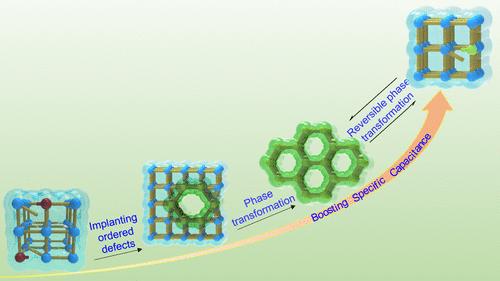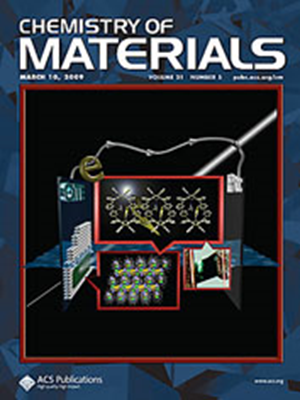Defect-Triggered Reversible Phase Transformation for Boosting Electrochemical Performance of Coordination Polymers
IF 7.2
2区 材料科学
Q2 CHEMISTRY, PHYSICAL
引用次数: 0
Abstract
Coordination polymers (CPs) hold promise for reliable and powerful supercapacitors (SCs) to overcome the energy crisis. However, CP-SCs face the daunting challenge of maintaining high pseudocapacitance after long-term charge/discharge cycling. Generally, if introducing defects exerted a positive effect on the property, eliminating defects would show a negative effect, and vice versa. Contrary to this common sense, here we demonstrate that both implanting defects and eliminating defects can significantly boost the specific capacitance of the defect-engineered CPs (DECPs), which are about 1.23 and 1.62 times that of the pristine CP, respectively, without loss of rate capability even after 10,000 charge–discharge cycles. The aqueous (A-ASC) and solid-state asymmetric supercapacitor (SS-ASC) devices based on DECPs deliver high energy densities of 80.3 and 61.5 Wh kg–1, superb power densities of 8471.0 and 8430.6 W kg–1, and long cycling lifespan of up to 2000 cycles with 92.0 and 80.0% capacity retention, respectively. Moreover, the SS-ASC exhibits excellent flexibility, verified by 99.0% maintenance of its initial capacitance when it is twisted and bent at 180°. Importantly, this work has certified that stepwise increasing/decreasing the concentration of ordered defects gradually triggered reversible phase transformation of CP from nonporous to microporous by charge–discharge cycling, in situ addition of the modulator, and postsynthetic treatment. The mechanism of forming/eliminating defects and their effects on supercapacitive performances of CP-SCs have been unprecedentedly clarified. These findings offer insight into the relationship between defective structure and electrochemical behavior for developing efficient long-cycling CP-SCs.

缺陷触发可逆相变,提升配位聚合物的电化学性能
配位聚合物(CPs)有望成为可靠而强大的超级电容器(SCs),以克服能源危机。然而,CP-SC 面临着在长期充放电循环后保持高假电容的严峻挑战。一般来说,如果引入缺陷会对性能产生积极影响,那么消除缺陷则会产生消极影响,反之亦然。与这一常识相反,我们在这里证明,植入缺陷和消除缺陷都能显著提高缺陷工程 CPs(DECPs)的比电容,其比电容分别是原始 CPs 的 1.23 倍和 1.62 倍,即使在 10,000 次充放电循环后也不会丧失速率能力。基于 DECPs 的水性(A-ASC)和固态非对称超级电容器(SS-ASC)器件的能量密度分别为 80.3 和 61.5 Wh kg-1,功率密度分别为 8471.0 和 8430.6 W kg-1,循环寿命长达 2000 次,容量保持率分别为 92.0 和 80.0%。此外,SS-ASC 还具有极佳的柔韧性,其初始电容在扭曲和弯曲 180° 时的保持率高达 99.0%。重要的是,这项研究证明,通过充放电循环、原位添加调制剂和后期合成处理,逐步提高/降低有序缺陷的浓度可逐渐引发 CP 从无孔到微孔的可逆相变。这些发现前所未有地阐明了形成/消除缺陷的机制及其对 CP-SC 超级电容性能的影响。这些发现有助于深入了解缺陷结构与电化学行为之间的关系,从而开发出高效的长循环 CP-SC。
本文章由计算机程序翻译,如有差异,请以英文原文为准。
求助全文
约1分钟内获得全文
求助全文
来源期刊

Chemistry of Materials
工程技术-材料科学:综合
CiteScore
14.10
自引率
5.80%
发文量
929
审稿时长
1.5 months
期刊介绍:
The journal Chemistry of Materials focuses on publishing original research at the intersection of materials science and chemistry. The studies published in the journal involve chemistry as a prominent component and explore topics such as the design, synthesis, characterization, processing, understanding, and application of functional or potentially functional materials. The journal covers various areas of interest, including inorganic and organic solid-state chemistry, nanomaterials, biomaterials, thin films and polymers, and composite/hybrid materials. The journal particularly seeks papers that highlight the creation or development of innovative materials with novel optical, electrical, magnetic, catalytic, or mechanical properties. It is essential that manuscripts on these topics have a primary focus on the chemistry of materials and represent a significant advancement compared to prior research. Before external reviews are sought, submitted manuscripts undergo a review process by a minimum of two editors to ensure their appropriateness for the journal and the presence of sufficient evidence of a significant advance that will be of broad interest to the materials chemistry community.
 求助内容:
求助内容: 应助结果提醒方式:
应助结果提醒方式:


